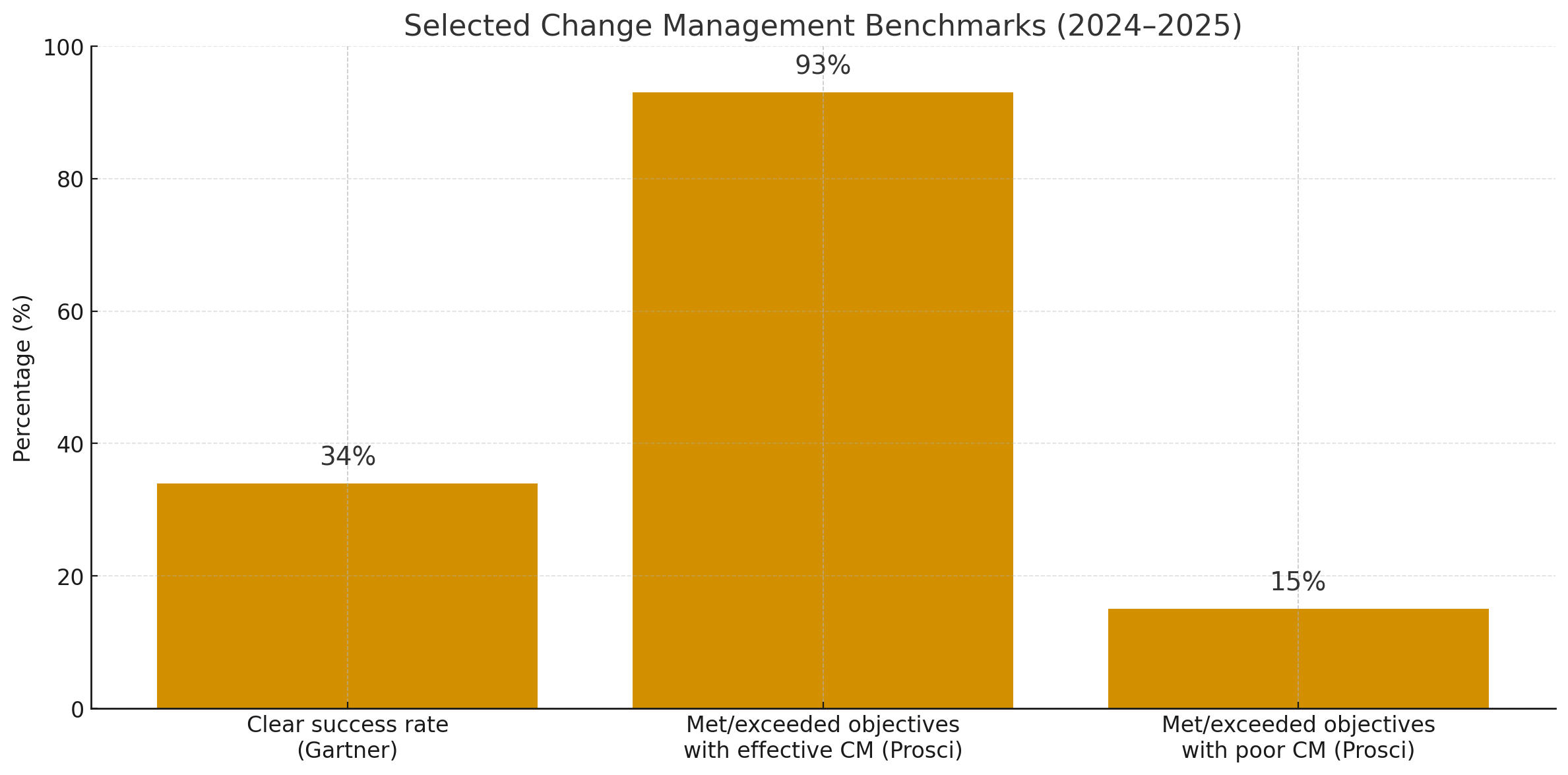Change is constant: new tools, new workflows, new market expectations. Many initiatives fail not because the idea is wrong, but because adoption is weak. The job of change management is simple: make the new way clear, doable, and worthwhile for both the business and the people who do the work.
Why change often stalls
- Unclear “why”: people hear what will change, but not why it matters now.
- Low sponsor visibility: if leaders are not visibly behind the change, teams hesitate.
- Impact not mapped: roles, handoffs, and documents shift, and nobody explains how.
- Training ≠ capability: attendance is tracked, proficiency is not.
- One-sided benefits: company gains are clear, personal gains are vague.
What actually works in practice
- One-page case for change: what changes, why now, how success will be measured, what will not change; share early and repeat.
- Map the impact: list operators, supervisors, planning, quality, suppliers, customers; note benefits, risks, and support needed.
- Visible sponsorship: show up in huddles, answer questions, remove blockers; people follow leaders more than slides.
- Champion network: pick respected peers to pilot, give feedback, and model the new behavior.
- Train for capability: keep it short and hands-on; define “done” as observable proficiency (scenario, checklist, sign-off).
- Two-sided benefits: pair business outcomes (quality, lead time, service) with personal gains (less rework, clearer roles, growth).
- Resistance log: capture concerns without judgment and turn each into an action with an owner.
- Rehearse go-live: dry-run handoffs, access, forms, labels, and escalation paths; make rollback criteria explicit.
- Support week one: daily check-ins, a visible way to ask for help, quick fixes to early issues.
- 30/60/90 reviews: show before/after metrics; if benefits are not visible, learn and adjust.
If you want a deeper look at leadership behaviors that help change stick, with real cases from operations, see Industrial Leadership.

Benchmarks that set expectations: roughly a third of transformations are clear successes; effective change management lifts the odds significantly versus weak practice.
What success looks like
Choose a small set of metrics and review them weekly:
- Adoption rate: who actually uses the new way
- Time-to-proficiency: how long until independent performance
- Usage depth: whether critical steps are truly used
- Support signals: help-desk tickets, rework, first-pass yield
- Pulse sentiment: quick checks on clarity and confidence

Adoption typically follows an S-curve across 12 months: slow start, steep middle, and a tail of reinforcement. Plan leadership time accordingly.
What I’ve seen in the field
I have always been pro-change when the potential is real and people are ready to succeed. Before I push a new workflow, I check capabilities role by role, pilot in a small area, and make the path visible: what changes, why now, and how we will know it works. When teams see a clear map and feel equipped, resistance falls quickly. The goal is not to announce change; the goal is to enable it.
Speaking a common language makes the turn possible. I translate strategy into daily tasks and show concrete benefits for both sides: fewer defects and better lead time for the company; less rework, clearer handoffs, and growth opportunities for individuals. We run short, hands-on practice until proficiency is observable. When people connect the change to their development, not only to the company’s targets, engagement rises and the new way sticks.
Early wins matter. I rely on respected champions from each shift, we measure adoption and time-to-proficiency, and we share small results quickly: a faster setup, a cleaner handoff, a simpler form. Visible progress builds trust. Teams feel that change is not done to them but built with them, and satisfaction moves in step with results.
I have also seen the opposite during supplier audits and trainings. Leaders rolled out new tools without mapping impacts or rehearsing the go-live. People were left with uncertainty: who approves exceptions, which document version is valid, where to get help. The best operators walked, not because they refused improvement, but because benefits were one-sided and ambiguous. When we reset with a clear case for change, a resistance log, and two-sided communication, momentum returned and attrition stopped.
These patterns are repeatable. Change works when leaders match ambition with capability, maintain visible sponsorship, and keep benefits tangible for both the business and the individual. For a broader view of the leadership behaviors behind these moves, illustrated with case examples, see Industrial Leadership.
Change is not a memo; it is a relationship. When leaders match ambition with capability, keep communication simple, and make benefits tangible for both the business and the individual, resistance turns into results.
